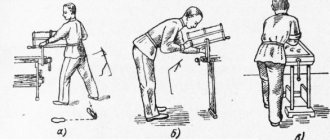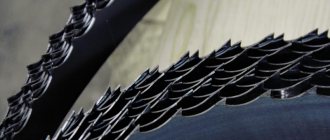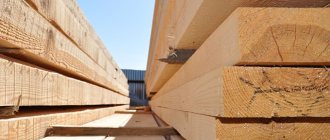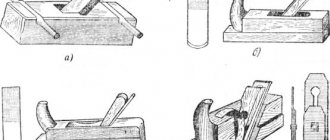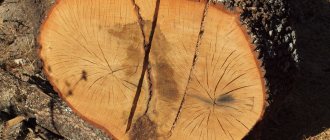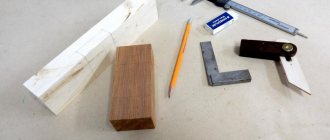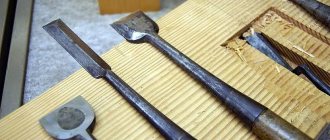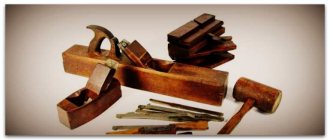Wood is a valuable natural material created by nature itself. People have been using this wonderful raw material for many centuries to build houses, create furniture, decorative interior items, and also use it for industrial purposes. For these reasons, proper processing of a felled trunk is an extremely important task. Sawing and planing wood are the most important operations with wood. In this article we will talk about what wood sawing is and what types of sawing exist.
Log sawing is the process of converting valuable natural raw materials into lumber. When sawing wood using different methods, you can obtain lumber of different sizes. To obtain high-quality products, you need to choose high-quality, even logs that are not damaged by pests.
Types of wood cutting
The quality of the final product depends on a large number of factors - the type of wood and the quality of the raw materials, the professionalism of the workers, and proper drying. However, there is another important aspect - this is the method of cutting timber.
There are the following cutting methods:
- tangential
- radial
- rustic
- longitudinal
- transverse.
Rustic is a cut that is performed at an acute angle to the direction of the grain. This method is used in the manufacture of lumber for rustic flooring, which can be called the most heterogeneous and original in pattern and shade.
During tangential cutting, the cutting plane lies tangentially to the annual layers of the material at a certain distance from the core. Since wood fibers are most often located in different directions, a natural pattern in the form of fancy “arches”, “curls”, “rings” is obtained on the surface. The structure of the board with this cutting option is heterogeneous; wood pores may be present. At the end of the tangential cut, the boards are characterized by an increased coefficient of shrinkage and swelling. Also, this log sawing scheme makes it possible to increase the useful yield coefficient, which causes a reduction in the cost of the final product.
Sawing wood blanks using the radial method is carried out perpendicular to the annual rings. Thus, a homogeneous board is obtained with the smallest gaps between annual layers. This creates an attractive pattern and also increases the strength of the lumber. Radial materials are characterized by high resistance to deformation and wear resistance. Also, such boards have lower rates of shrinkage and swelling compared to tangentially cut lumber. Therefore, finished products, for example, parquet boards, floorboards, block houses, linings, practically do not crack on the front part, but tangentially sawn materials are susceptible to such phenomena. Glued laminated timber is created only from radial and semi-radial cut boards, because the mechanical and geometric parameters are directly dependent on the resistance of the fibers. This resistance increases during gluing of layers with multidirectional annual rings at an inclination angle of no more than 45°.
Only 10-15% of radial boards can be obtained from a single log. Therefore they have a high cost. The best performance is demonstrated by material having an angle between the annual layers and the cutting plane from 80 to 90 degrees.
Sawing wood across the grain
The technology of sawing wood across the grain is the most common method of processing timber in carpentry. At the same time, such sawing can be called the simplest. Longitudinal sawing of wood requires much more effort and certain skills.
Tools for cross-cutting timber are selected depending on the required accuracy, the amount of work and the conditions available in each individual workshop. You can use:
- electric circular saw. She makes neat and fast cuts. For domestic use, a model with a 1000 W motor and a disk cross-section of 180 mm is perfect. Most circular saws come with a combination blade that can be used for a wide variety of jobs. The teeth of this blade are something between the teeth of a transverse and longitudinal saw. For long-term work, it is better to take a blade that is coated with carbide. Its cost is higher, but it takes 10 times longer to dull
- miter box and tenon saw. They are used for finishing. These tools can be used to make the most precise cuts.
- circular saw
- cross saw. When purchasing, please note that the teeth of such a tool should be alternately positioned to the left and to the right of the blade itself. They must be well sharpened and beveled. The most popular is a saw with 10 teeth per 25 mm blade. With 8 teeth, the saw will cut faster, but will create rough cuts.
Hand sawing
Sawing with a carpenter's hacksawSawing is used to cut boards into bars, trim planed parts to length, and file tenons and eyes. The sawing tool - the saw - is a steel blade with cutters-teeth cut along the edge. The entire row of saw teeth is called the ring gear.
For hand sawing use a carpenter's saw
– a saw with
cutter teeth
.
According to the direction of cutting the fibers, transverse, longitudinal and mixed sawing are distinguished. When cross-
cutting,
the direction of the cut (cut) is perpendicular to the grain.
When longitudinal sawing
- parallel to the grain.
When mixed sawing
, it is directed at an angle to them.
For cross cutting
For workpieces, saws are used whose teeth have
a straight triangular profile
, and for
longitudinal sawing
- saws with
an inclined tooth profile
.
Hand saws are available with fine and coarse teeth.
For crosscut
sawing, the sharp cutting edges of the tops of the teeth alternately cut the wood fibers and remove the broken wood particles in the form of sawdust.
In rip
saws, the cutting edges of the inclined teeth protruding forward cut off the wood fibers and the cut particles are chipped along the fibers, forming sawdust. The figures below show the shapes of the teeth and the patterns for cutting fibers with longitudinal and transverse saws.
When sawing, the saw blade rubs against the walls of the separated parts of the wood. And so that it does not get pinched in the cut, the saw teeth must be set apart
(set of teeth), i.e., alternately bent in different directions.
This makes the cut a little wider and makes sawing easier. Below is a type of setting
for setting the teeth apart.
When sawing workpieces, they retreat from the marking line by 2-3 mm.
The hacksaw blade should move at right angles to the workpiece.
Sawing control
carried out along the marking line. It should remain to the left of the sawing point on the workpiece.
For more precise sawing of wood or plywood blanks, saws with fine teeth are used. The inclination of the saw is shown in the figure.
This is how they work with a hacksaw. The marked workpiece is placed on a board (1) on a carpentry bench that has a stop (2). With your left hand you press the workpiece against the stop, and with your right hand you make a cut. In this case, the hacksaw is pressed against the stop and several short smooth movements are made towards you. After sawing, the hacksaw is moved along its entire length, aligning it with the marking line of the cut.
By moving the saw along the line, an incision is made, then the block is removed and the part is sawed off. At the end of sawing, the pressure on the saw is eased so as not to break off the wood fibers at the exit of the saw. The position of the hands when sawing is shown in the figure.
Miter boxes are used for precise sawing of bars and boards at angles of 90°, 45°, 60° and others.
.
The miter box
has a grooved shape. It consists of a bottom 1, two sidewalls 2, between which the workpiece to be cut 3 is clamped. The sidewalls have cuts made at the desired angle. Saw blade 4 is inserted into these cuts and sawing is performed at the desired angle.
The use of a miter box eliminates marking of the part, increases the accuracy of sawing, reduces the time spent on marking the part, thus increasing labor productivity. The use of a miter box is especially effective in mass production.
details. The miter box may look like the one shown in the photo.
tsulaga is also used
.
Tsulaga
is very quickly made from a sheet of plywood or board and two bars. Thanks to the lower bar, it is easy to press it to the tabletop, and the upper one serves to support the workpiece. The tsulaga can be made with a movable stop for sawing off a large number of identical parts.
Sawing techniques using tsulaga, miter box, stops
, are shown in the figures.
For sawing different workpieces and figure cutting, different saws and hacksaws are used. Examples are given in the figure.
Wood sawing is used to obtain workpieces of the required size and parts of various contours in order to reduce subsequent processing by cutting and planing.
A hand saw consists of two main parts: the saw blade or handle, which is used to hold the saw while working, and the saw blade.
Each saw tooth represents a cutter. The saw teeth, bent alternately to the sides, form a so-called set, which facilitates the movement of the saw blade, since the cut is wider than the thickness of the blade.
Based on the size of the teeth, saws are divided into fine-toothed (tooth height up to 3 mm), normal (tooth height 4-5 mm) and coarse-toothed (tooth height 6-8 mm).
Fine-tooth saws are used for precise work, and coarse-tooth saws are used for rough sawing on soft or raw wood.
Hand saws
A crosscut saw is designed to cut wood across the grain; its teeth are shaped.
A rip saw is used to cut wood along the grain. Its main difference from a cross-cut saw is the absence of side edges on the teeth.
A saw for universal sawing, used for sawing in both longitudinal and transverse directions, differs in the shape of the tooth.
According to their design, saws are divided into saws with a tensioned blade and saws with a free blade.
The bow saw is a type of saw with a tensioned blade. It can be used for a wide variety of jobs, depending on the width of the supplied blade and the shape of its teeth.
Hacksaws (ship saws, ax saws) have a free wide blade with teeth of various shapes and sizes. Thanks to their ability to maintain the direction of the cut, hacksaws are very convenient for modeling.
Sharpening hand saws
Working with a dull or faulty saw is difficult and unproductive, so before you start working, you need to put the saw in order and make sure it is sharpened correctly. To do this, remove tar and rust from the surface of the saw with a rag soaked in kerosene, then, if the saw was bent, straighten it. The saw should be straightened with a mallet on a flat metal surface.
The straightened saw is clamped in a bench or special vice with the teeth up and the teeth are aligned in height and shape with a triangular personal file, and then they begin to set them. When setting the saw, the teeth along the entire length of the saw are bent alternately in opposite directions.
As a result of setting the teeth, the cut is wider than the blade, and the saw moves easily in the cut.
A poorly set saw produces an uneven cut and leads to the sides.
The saws are set with a special tool - a setter. The saw teeth are bent one after another in one direction, and the missing teeth are bent in the opposite direction. If there is no wiring, this work can be done with a screwdriver.
After setting, the saw is sharpened with a personal triangular or diamond-shaped file.
Jigsaws are a type of small manual or mechanical machine with tensioned thin saw blades, so-called jigsaw blades.
Jigsaws are used for the most delicate and delicate work, mainly for cutting shaped holes and curved cuts.
The design of the jigsaw depends on the size of the parts being cut and what material needs to be cut. To work on hard wood, plastics and metal, metal jigsaws with a slight offset are used. To work on plywood, use a wooden or metal jigsaw with a large offset.
Jigsaw blades are commercially known as “metal saws” and “wood saws.” Working with a jigsaw requires great care, since even with a slight misalignment of the jigsaw, the file easily breaks.
As a rule, a jigsaw is used on a stand that is screwed to a board or table. Especially small work on plastic and metal is done by clamping the part in a table vise.
When working in a vice, the file is clamped in the “tooth away from the handle” direction, when working on a stand - “tooth towards the handle”.
Good jigsaw files should be elastic and have clear, sharp teeth. The file should not have one-sided burrs resulting from the manufacture of the file, as they cause inevitable deviation of the cut to the side. To avoid jamming, leading to breakage, files wider than 1 mm must have a routing.
Along with flat files, round files are sometimes used, which allow you to make cuts in any direction without turning the jigsaw, simply by pressing its handle in the desired direction.
To cut grooves in plates, for example, ribs, several files are successfully used, which are clamped simultaneously. The cutting width is adjusted by the number of files.
If you don’t have files, you can make them yourself from flattened wire or a clock spring 1-2 mm wide.
To do this, you need to straighten the workpiece and clamp it in a vice, cut through the teeth through one with a small needle file, then turn the workpiece and saw through the missing teeth on the other side in the opposite direction. By using this method, the formation of one-sided burrs on both sides is avoided, and the canvas receives a unique layout.
You can make a file in another way. To do this, a straightened clock spring or a strip of spring steel of the required thickness is clamped between two plates in a vice and the teeth are cut with a sharp chisel.
Mechanical jigsaws
The performance of internal sawing work is greatly facilitated and improved with the help of mechanical jigsaws.
For mechanical jigsaws, files up to 200 mm long with a tooth height of 0.8 to 2 mm are used, depending on the thickness of the material being cut. Thanks to the correct movement of the saw and the large number of strokes per minute on mechanical jigsaws, you can saw several parts of the same type at once in a package up to 30-40 mm thick.
By design, there are spring and frame mechanical jigsaws.
A spring jigsaw consists of a frame and a crank mechanism with a return spring. The simple design of such a machine allows you to make it yourself in a locksmith workshop.
A frame jigsaw consists of a movable frame on which a file is stretched, a table frame and a crank mechanism that drives the frame. A frame jigsaw provides slightly more favorable conditions for saw operation than a spring jigsaw.
Working methods and accessories for sawing
Devices make work easier and also increase accuracy. These include stop bars on the table, a vice on the workbench, and a wedge for clamping the part on the workbench.
For precise cutting at a given angle, a device called a miter box is used. This is a wooden box made of well-fitted bars with precise slots located at angles of 90°, 45° and 30° to the longitudinal axis of the box. When working in a miter box, the part is clamped with a clamp or wedge inside it so that the cut passes in the right place. The saw blade, inserted into the slot, does not have the opportunity to move to the sides when moving, which ensures an accurate and even cut.
First of all, you should pay attention to sawing, that is, the beginning of the cut. It is important to prevent the saw from jumping and start cutting exactly according to the markings.
Securely secure the workpiece when sawing. Use stops, miter boxes and other devices. Sawing only with a serviceable, sharply sharpened saw. Do not allow the saw to skew when sawing. Do not make sudden movements with the saw. Do not keep your left hand close to the saw blade. Place the saw on the workbench with the teeth facing away from you. Do not blow away sawdust or sweep it away by hand. Use only a brush.
